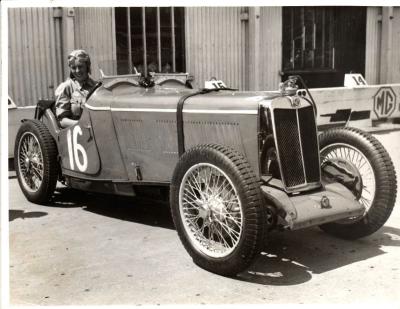Kate Walker: MG's Dancing Daughters
These days, women in top-tier motorsport are something of a rarity. It is in the United States that women have been best able to make their mark behind the wheel in the 21st century: Simona de Silvestro, Katherine Legge, Pippa Mann, Danica Patrick...
But it was not always thus. In the years before Formula One, when Europe played host to endless grands prix and grandes ?preuves, women were a regular fixture behind the wheel: setting lap records at Brooklands, taking part in land speed record attempts at Montlhery, and devising crazy feats to test a car's ability - such as driving an Invicta around the world, taking in Europe, Africa, India, Australia, the United States, and Canada in five short months back in 1927.
The early women racers were usually competing in a different class to their male rivals, fighting for a Coup des Dames and not the overall win, but there were occasions when the women were able to beat their male colleagues at their own game, and the trophy was handed to not the driver of the car who had finished first, but to the man who had finished first behind the women.
That being said, women were still enough of a rarity in motorsport that their presence - and their talent, for the marquee names of the 1920s and 1930s were no slouches behind the wheel - was often taken advantage of by manufacturers seeking additional publicity for their on-track exploits.
Perhaps the best-known all-female marketing initiative of the 1930s came about via MG, who ran a number of women-only Le Mans entries in the middle of that decade under the banner Eyston's Dancing Daughters.
Coached by George Eyston, then a star of the racing and land speed record scenes, the all-women teams were comprised of serious female racing talent: Brooklands lap record holders; MG works drivers; winners of rallies, hill climbs, and club events. While the initiative was designed to promote the company's new P-Series car, that promotion would have been for naught had the women behind the wheel not delivered on track.
In 1935, three Eyston-coached teams entered the infamous endurance race: #54, driven by Margaret Allen (n?e Jennings) and Coleen Eaton; #55, driven by Doreen Evans and Barbara Skinner; and #56, driven by Joan Richmond and Barbara Simpson. Unusually for the time, all three entries finished the race. The only maintenance work needed in the pits? At one point, the number 55 car needed a new light bulb.
As a marketing exercise, it proved highly effective: the MG PA Midget was so bulletproof that it could be driven by women - at night! - and still prove reliable. Those crazy dames...
But as any racing fan knows, simply having a reliable car is not enough to make it to the finish at Le Mans. The race is a punishing affair these days, when drivers are in communication with their teams on the pit wall, and they can be forewarned of faster cars coming up behind, or slower cars ahead, their progress past cars of different classes managed by information.
Le Mans in the 1930s was a very different beast, with tech teams and drivers alike working blindly, trusting on talent and instinct to make it to the finish. The night section was particularly perilous, as all challengers were equipped with headlamps less powerful than the torch app on a modern iPhone. Any competitor - male or female - who lucked into a reliable car still needed to make the most of their racing skill to make it to the chequered flag.
While all-female teams of MG drivers were a not infrequent sight at Le Mans in the 1930s, it is 1935 that is best remembered for its Dancing Daughters. All three entries made it to the end of the race, although the 0.8l MG PA Midgets were only able to manage 153 laps (152 laps for Allen and Eaton) of the 222 completed by overall winners Johnny Hindmarsh and Luis Fontes, who were driving a Lagonda M45R Rapide powered by a 4.5l Meadows engine.
Of the original Dancing Daughters, Allen and Evans went on to have successful enough racing careers that their names have endured, with the pair taking part (separately) in a variety of different racing categories before the Second World War brought a temporary end to motorsport in Europe. But a quick scan of Le Mans entrants in the 1930s brings up a number of names familiar to students of the 'fast women' of the pre-war era: Kay Petre, Gwenda Stewart, Elsie Wisdom...
Perhaps the one name from the Le Mans record books that should have a far greater impact than it does at present is that of Odette Siko, who competed between 1930 and 1933, collecting an overall P4 finish, two top-ten overall finishes, and one class victory in her years as a Le Mans entrant. Sadly, she lacked the backing and branding of a major marque, and despite being Le Mans' first - and most successful - female entrant, Siko has largely been forgotten.
By Kate Walker
Image: Brooklands Museum; courtesy of Brooklands Society Archive


![Johann Zarco, LCR, Honda RC213V, 2024 San Marino MotoGP, Misano, action [Gold & Goose]](https://cdn.crash.net/styles/thumbnail/s3/2024-09/GnG_1166323_HiRes.jpg?itok=vpgrU7Q4)

![Jack Miller, KTM Factory Racing, KTM RC16, San Marino MotoGP, Misano, action [Gold & Goose]](https://cdn.crash.net/styles/thumbnail/s3/2024-09/GnG_1167624_HiRes.jpg?itok=iz7mA4EQ)


![Fabio Quartararo, Monster Energy Yamaha Racing, Yamaha M1, 2024 MotoGP, Misano Test, action [Gold & Goose]](https://cdn.crash.net/styles/thumbnail/s3/2024-09/GnG_1168928_HiRes.jpg?itok=fcYSole_)
![Toprak Razgatlioglu, ROKiT BMW Motorrad, BMW M 1000 RR, Magny-Cours, WorldSBK [Gold & Goose]](https://cdn.crash.net/styles/thumbnail/s3/2024-09/GnG_1165133_HiRes.jpg?itok=GD5SVNVG)

